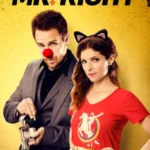 Mr. Right (2015), directed by Paco Cabezas and starring Sam Rockwell and Anna Kendrick, is one of those movies that dares to be audaciously uneven, wildly entertaining, and completely bizarre. Part romantic comedy, part action thriller, and part darkly comic commentary on morality, the film embraces chaos with reckless abandon. It’s a film that thrills, confounds, and occasionally makes you question your life choices for watching it—but that’s precisely what makes it “awesome terrible.” Watching Mr. Right is like sitting in a high-speed car chase while simultaneously being serenaded by absurd romantic clichés: exhilarating, ridiculous, and unforgettable.
Mr. Right (2015), directed by Paco Cabezas and starring Sam Rockwell and Anna Kendrick, is one of those movies that dares to be audaciously uneven, wildly entertaining, and completely bizarre. Part romantic comedy, part action thriller, and part darkly comic commentary on morality, the film embraces chaos with reckless abandon. It’s a film that thrills, confounds, and occasionally makes you question your life choices for watching it—but that’s precisely what makes it “awesome terrible.” Watching Mr. Right is like sitting in a high-speed car chase while simultaneously being serenaded by absurd romantic clichés: exhilarating, ridiculous, and unforgettable.
The premise is deliciously strange. Martha McKay (Anna Kendrick) is a young woman who, disillusioned by bad relationships, inadvertently falls for Francis Munch (Sam Rockwell), a charming man who also happens to be a former hitman. Francis has a strict moral code: he only kills bad people, often using imaginative and inventive methods that are both gruesome and darkly humorous. As Martha discovers the truth about her new boyfriend, the two navigate a twisted world of crime, romance, and chaos, all while evading vengeful gangsters and federal agents. This setup allows the film to oscillate effortlessly between romance, comedy, and action, though not always seamlessly.
One of the film’s greatest strengths—and its most maddening flaw—is its tonal audacity. Mr. Right refuses to play it safe, blending romantic comedy tropes with absurdly violent action sequences and moral ambiguity. The romance between Martha and Francis is sweet, awkward, and strangely believable, yet constantly undercut by bullets, explosions, and bizarre assassination techniques. This oscillation between genres creates a viewing experience that is unpredictable and thrilling, though sometimes disorienting. It is the ultimate “awesome terrible” movie: chaotic, entertaining, and occasionally head-scratchingly illogical.
Sam Rockwell’s performance as Francis Munch is the centerpiece of the film’s charm. Rockwell fully commits to the role, balancing charm, menace, and comic timing in equal measure. Francis is simultaneously terrifying and endearing, a hitman with a conscience and an awkward romantic streak. Rockwell’s ability to oscillate between deadpan humor, sudden violence, and vulnerability makes the character memorable and keeps the audience engaged even when the plot veers into absurdity. His charisma is magnetic, and it anchors the film amid its tonal swings.
Anna Kendrick as Martha is equally compelling, providing a grounded emotional center in a narrative that often feels untethered. Kendrick brings humor, intelligence, and genuine vulnerability to her role, making Martha’s reactions to the increasingly bizarre events both relatable and entertaining. The chemistry between Kendrick and Rockwell is quirky, slightly offbeat, and surprisingly convincing, ensuring that the romantic subplot remains engaging even amid carnage and chaos. Their interactions are a highlight of the film, offering moments of tenderness and absurd humor that are genuinely delightful.
The action sequences in Mr. Right are another defining feature. Francis’ inventive assassination techniques, often involving everyday objects or absurdly creative setups, are simultaneously shocking, hilarious, and grotesque. From nail guns to exploding coffins, the film revels in over-the-top violence, creating a visual spectacle that is as entertaining as it is ridiculous. These sequences are choreographed with flair, balancing humor and tension in a way that keeps viewers on edge while laughing at the audacity of it all. The action is inventive and visually engaging, a testament to the film’s commitment to embracing its own chaotic premise.
The script, written by Max Landis, is a mix of witty dialogue, dark humor, and absurdly exaggerated scenarios. While the humor lands in many places—particularly in the banter between Francis and Martha—some jokes miss their mark or feel jarringly out of place amid the darker sequences. The film’s dialogue is clever, often absurd, and occasionally self-aware, contributing to its unique tonal mix. It’s a script that requires a viewer willing to embrace unpredictability, as the narrative careens from heartfelt romantic beats to violent action set pieces with little transition.
One of the film’s most interesting aspects is its moral complexity. Francis’ hitman activities are framed within a strict personal code: he kills only those who deserve it. This moral ambiguity allows the film to explore questions of justice, ethics, and love in a stylized, exaggerated way. The audience is invited to root for a killer, yet the film softens the moral weight through humor, romance, and Rockwell’s charismatic performance. This balancing act contributes to the “awesome” side of the film: it’s clever, provocative, and morally audacious.
Yet Mr. Right is undeniably “terrible” in many respects. Its narrative often stretches credibility, with plot points that hinge on improbable coincidences or absurd character decisions. Some supporting characters are thinly sketched or cartoonish, serving primarily as targets, obstacles, or comic relief. Tonal shifts, while often entertaining, can also feel jarring, leaving viewers unsure whether to laugh, gasp, or feel suspense. The film’s willingness to embrace absurdity and chaos is both its greatest charm and its most frustrating flaw. It is a movie that delights in being unpredictable, even when that unpredictability veers into confusion.
The supporting cast, including Michael Eklund, Anson Mount, and James Ransone, adds flavor and occasional comic relief, though many characters are underdeveloped or exist primarily to advance the plot. Their performances are entertaining, but the focus remains squarely on Rockwell and Kendrick, whose chemistry drives the film. The narrative’s occasional reliance on caricatured villains and improbable scenarios contributes to the “terrible” side of the experience, creating moments that are amusing, baffling, or both.
Cinematography and visual style also contribute to the film’s unique flavor. The action sequences are slick and inventive, often employing dynamic camera angles, rapid cuts, and stylistic flourishes that heighten tension and absurdity. The color palette is bright and energetic, reinforcing the film’s playful tone even amid carnage. These choices help create a cohesive visual identity that is both stylish and deliberately exaggerated, enhancing the sense of controlled chaos that permeates the narrative.
The humor, while uneven, is a highlight of the film. Mr. Right mixes dark comedy, absurdist situations, and witty dialogue, often within the same scene. The film’s willingness to juxtapose romance and murder, tenderness and brutality, creates moments that are simultaneously hilarious and thrilling. Some jokes land better than others, and the tonal juggling act can feel exhausting at times, but the film’s boldness ensures that it remains entertaining throughout. It’s a film that rewards viewers who appreciate audacity, risk-taking, and unpredictability.
Romantic beats in Mr. Right are similarly adventurous. Martha and Francis’ relationship develops amid extraordinary circumstances, mixing awkward charm, physical danger, and genuine emotion. Their romance is surprisingly sweet, balancing humor with sincerity, and serves as the emotional anchor amid the film’s chaos. The narrative occasionally undermines this romance with improbable plot twists or sudden violence, yet the connection between the leads remains engaging and compelling. This tension between romance and absurdity is central to the film’s “awesome terrible” identity: it is unpredictable, entertaining, and frequently ridiculous.
The soundtrack, featuring a mix of upbeat tracks and suspenseful scoring, complements the film’s tonal swings. Music enhances the energy of action sequences, underscores comedic moments, and adds atmosphere to romantic beats. While not always perfectly matched, the score contributes to the film’s sense of fun and chaos, reinforcing its identity as a wildly unconventional experience.
Ultimately, Mr. Right is a film of extremes. It is stylish, inventive, and frequently hilarious, yet narratively inconsistent, tonally erratic, and occasionally baffling. Its charm lies in its willingness to embrace unpredictability, to oscillate between romance, comedy, and violence without apology. The film thrives on chaos, absurdity, and audacious performances, creating a cinematic experience that is equal parts thrilling, funny, and bewildering. It is the kind of movie that invites repeated viewings, debate, and laughter at the sheer audacity of it all.
Thematically, the film explores morality, love, and identity in ways that are both clever and over-the-top. Francis’ moral code, Martha’s personal growth, and the film’s examination of choice and consequence provide substance amid the chaos. While these themes are occasionally overshadowed by action and absurdity, they give the film depth and allow it to resonate beyond its surface-level thrills. It’s a movie that is self-aware yet committed to entertaining, balancing thoughtfulness with sheer cinematic audacity.
In the end, Mr. Right is perfectly imperfect—a film that is as fun as it is flawed. Its combination of inventive action, dark humor, quirky romance, and narrative absurdity makes it a quintessential “awesome terrible” movie. Rockwell and Kendrick’s performances anchor the film, providing heart amid the chaos, while the direction, cinematography, and script embrace boldness, risk-taking, and unpredictability. Its flaws are inseparable from its appeal, creating a viewing experience that is memorable, thrilling, and amusing in equal measure.
For those willing to embrace the absurdity, moral ambiguity, and chaotic energy of Mr. Right, the film delivers a wildly entertaining ride through bullets, romance, and dark comedy. It is a movie that makes you laugh, gasp, and occasionally shake your head in disbelief—all at once. It is audacious, unpredictable, and endlessly discussable—a cult favorite for fans of “so bad it’s amazing” cinema.
This post has already been read 46 times!




